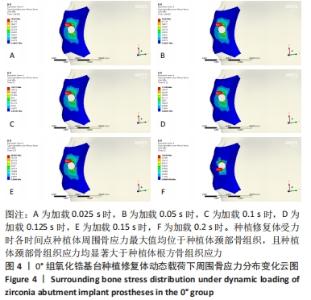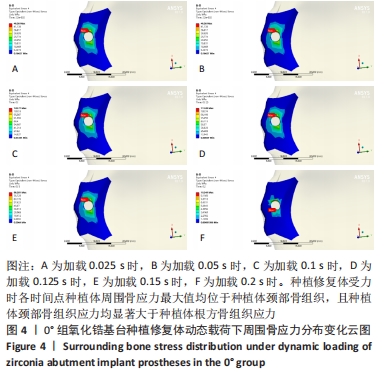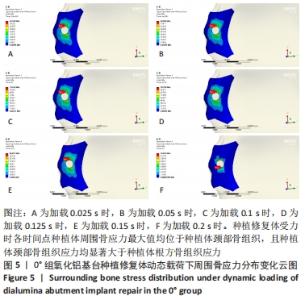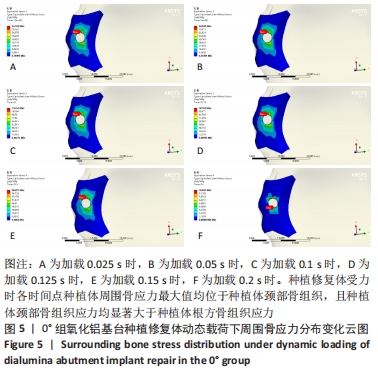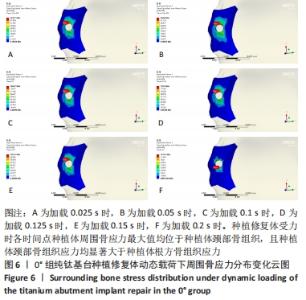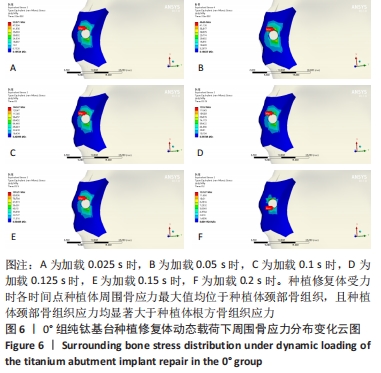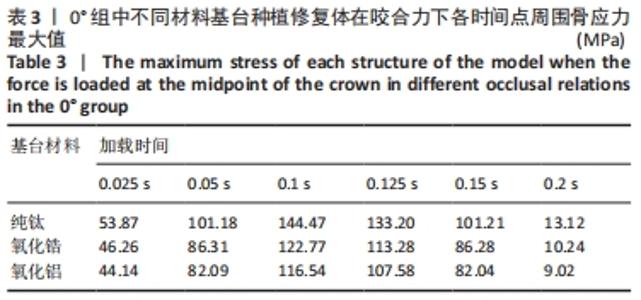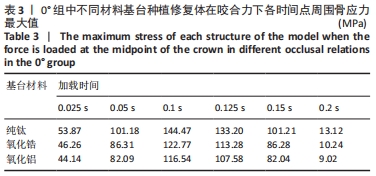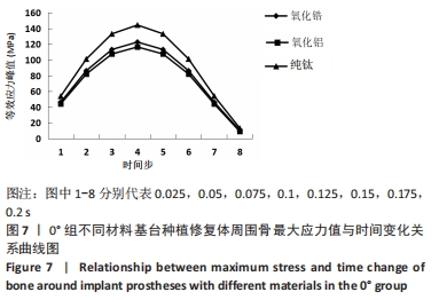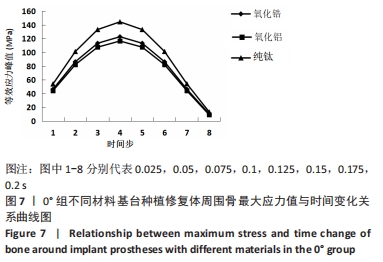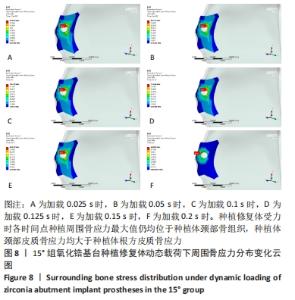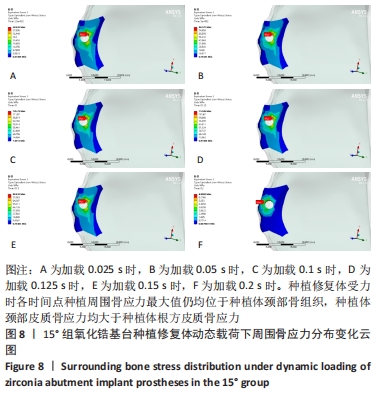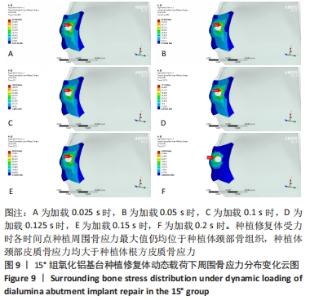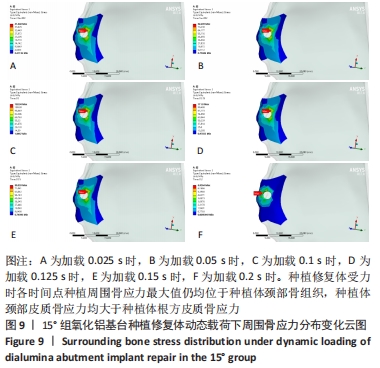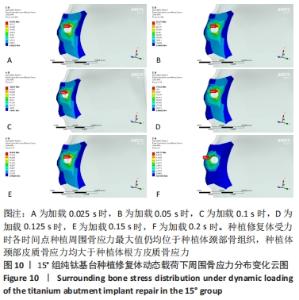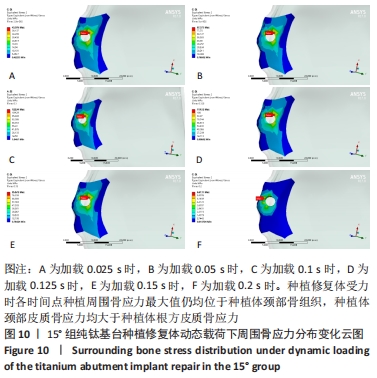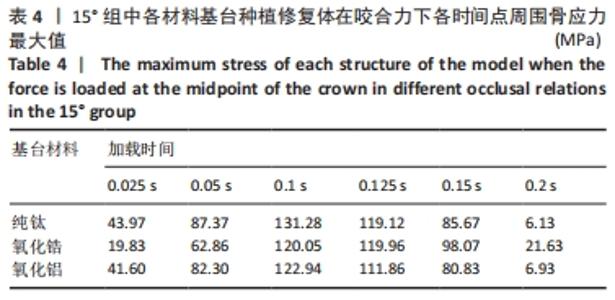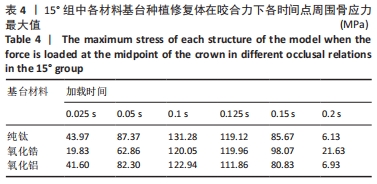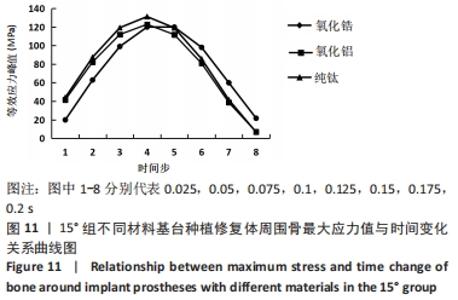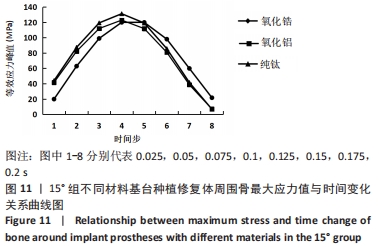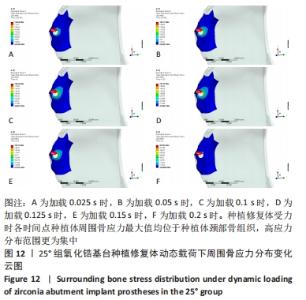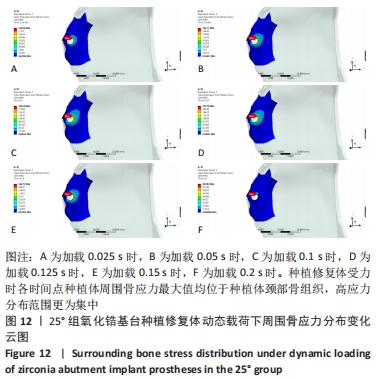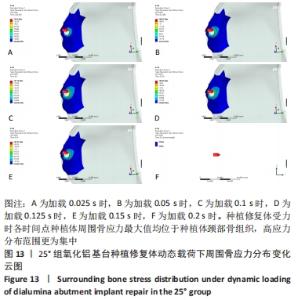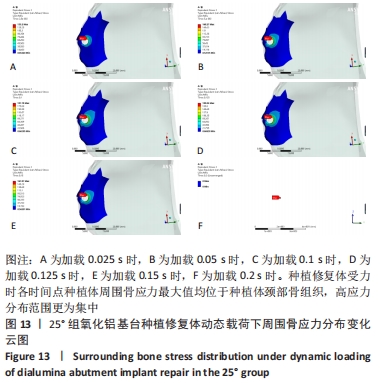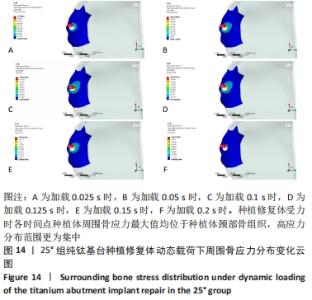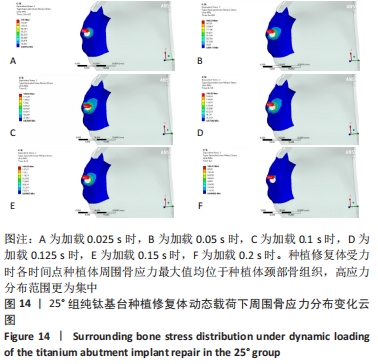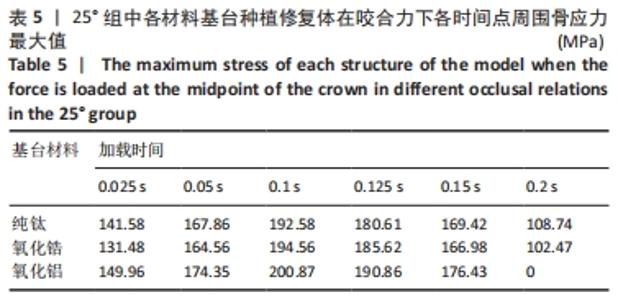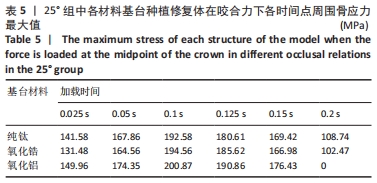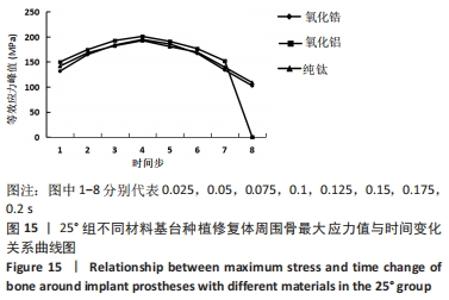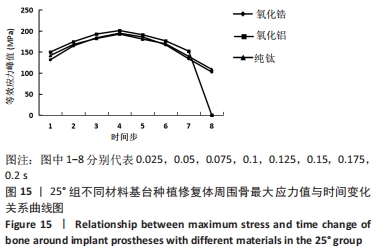Chinese Journal of Tissue Engineering Research ›› 2023, Vol. 27 ›› Issue (3): 398-405.doi: 10.12307/2023.012
Previous Articles Next Articles
Effect of three abutment materials on bone stress around maxillary angle implant under dynamic loading
Wang Junxiang, Sun Jiangwei, Bai Bujiafu·Yellisi, Wang Zhaoxin, Nijati·Turson
- Department of Stomatology, Second Affiliated Hospital of Xinjiang Medical University, Urumqi 830063, Xinjiang Uygur Autonomous Region, China
-
Received:2021-10-25Accepted:2021-12-10Online:2023-01-28Published:2022-05-20 -
Contact:Nijati·Turson, Chief physician, Associate professor, Department of Stomatology, Second Affiliated Hospital of Xinjiang Medical University, Urumqi 830063, Xinjiang Uygur Autonomous Region, China -
About author:Wang Junxiang, Master candidate, Department of Stomatology, Second Affiliated Hospital of Xinjiang Medical University, Urumqi 830063, Xinjiang Uygur Autonomous Region, China -
Supported by:Natural Science Foundation of Xinjiang Uygur Autonomous Region, No. 2016D01c192 (to NT)
CLC Number:
Cite this article
Wang Junxiang, Sun Jiangwei, Bai Bujiafu·Yellisi, Wang Zhaoxin, Nijati·Turson. Effect of three abutment materials on bone stress around maxillary angle implant under dynamic loading[J]. Chinese Journal of Tissue Engineering Research, 2023, 27(3): 398-405.
share this article
Add to citation manager EndNote|Reference Manager|ProCite|BibTeX|RefWorks

2.4 总结 不同植入角度下,3种材料基台种植修复体在受咬合力时周围骨应力峰值分布一致,均位于种植体颈部骨皮质,各材料基台种植修复体周围骨应力上升幅度最快时间段均为0.025-0.05 s内,15°组骨皮质高应力值范围较0°组更大,25°组种植体骨皮质初始应力值明显高于其余两角度组,且加载结束后骨皮质残留较高应力值;钛基台种植修复体周围骨应力上升幅度最大,高应力值范围较为集中;在15°组中,3种材料基台种植修复体周围骨应力峰值均位于种植体颈部,应力上升幅度钛基台种植修复体周围骨应力上升幅度较大但并不明显,高应力分布范围较为一致。25°组相较于其余两角度组应力高值较为集中,应力起始值高且变化幅度更大,其中氧化铝基台种植修复体周围骨应力在0-0.1 s内上升幅度最大,在0.2 s时氧化锆基台种植修复体骨等效应力峰值降为0,其余两种材料基台种植修复体周围骨内均残留较高应力。"

| [1] WANG L, YOU X, LOTINUN S, et al. Mechanical sensing protein PIEZO1 regulates bone homeostasis via osteoblast-osteoclast crosstalk. Nat Commun. 2020;11(1):282. [2] 韩丽,邱晓霞,邢旭娜,等.上颌前牙区种植方案中角度设计的三维有限元分析[J].上海口腔医学,2015,24(2):157-163. [3] 王淑英,江青松,蒋向华,等.钛基台支持的CAD/CAM全瓷单冠不同载荷位置的三维有限元应力分析[J].北京口腔医学,2019,27(2):72-75. [4] 魏玮,张寒,陈梦琦,等.钛材料仿生天然磨牙的三维有限元分析[J].南京医科大学学报,2019,39(7):1057-1061. [5] 雍苓,黄仕禄,刘洪,等.不同骨缺损类型牙种植体的三维有限元分析[J].医用生物力学,2016,31(2)148-153. [6] HUSSEIN FA, SALLOOMl KN, ABDULRAHMAN BY, et al. Effect of thread depth and implant shape on stress distribution in anterior and posterior regions of mandible bone:A finite element analysis. Dent Res J. 2019;16(3):200-207. [7] 朱岩峰,陈伟辉,陈舟.上中切牙种植修复后3种受载应力分布的有限元分析[J].福建医科大学报,2015,49(2):127-130. [8] 马富,赵红建.晶化温度对合成二氧化锆介孔分子筛介观结构的影响[J].宁夏师范学院学报,2012,33(6):44-47. [9] 唐代名.金属材料学[M].成都:西南佳交通大学出版社,2014. [10] 王丽萍,郭昭华,池君洲,王永旺,陈东.氧化铝多用途开发研究进展[J].无机盐工业,2015,47(6):11-15. [11] 邹晖,李朝晖,徐盛,等.不同垂直骨面型成人上下颌后牙区皮质骨密度测量研究[J].中华口腔医学研究杂志(电子版),2020,14(5):308-313. [12] 黄英,张慧,蔡跃,等.缺牙区松质骨密度的定量CT法测量[J].中国组织工程研究,2017,21(36):5775-5780. [13] 辛海涛,梁照,赵雯.动态有限元法在前牙咬合过程分析中的应用[J].上海口腔医学,2008,17(6):648-651. [14] 张新春,陈慧芝,滕伟,等.动态载荷下三种形式箍效应的有限元分析[J].南方医科大学学报,2008,28(9):1646-1648. [15] Frost HM. A 2003 update of bone physiology and Wolff’s Law for clinicians. Angle Orthod. 2004;74(1):3-15. [16] 刘振东,秦泗河.骨折固定的四维空间事件[J].中国组织工程研究,2020, 24(6):903-910. [17] 林伟斌,朱聪,洪海森,等.体外周期性压应力对兔胫骨骨折愈合过程成骨与破骨细胞增殖分化能力的影响[J].中华损伤与修复杂志(电子版), 2021,16(4):289-300. [18] 安尼卡尔·安尼瓦尔,艾孜买提江·赛依提,阿迪力·麦木提敏,等.唇侧植骨不同种植修复体的三维有限元分析[J].医用生物力学,2020,35(4): 304-310. [19] 安尼卡尔·安尼瓦尔,帕丽黛姆·图尔迪,阿迪力·麦木提敏,等.上颌前牙区不同种植修复体在不同咬合受力下的三维有限元分析[J].中国组织工程研究,2020,24(16):2531-2536. [20] 徐俊华,JiangJonathan,沈晨露,等.个性化氧化锆基台对种植体周围软硬组织影响的前瞻性临床研究[J].中华口腔医学杂志,2020,55(11):885-890. [21] 杨炎忠,周延民,田小华,等.不同结构氧化锆瓷基台及种植体周骨壁应力的有限元分析[J].现代口腔医学杂志,2008,22(6):624-627. [22] 朱岩峰,陈伟辉,陈舟.上中切牙种植修复后3种受载应力分布的有限元分析[J].福建医科大学学报,2015(2):127-130. [23] 李英,孙超,贾慧,等.动态载荷下下颌牙列缺失前牙区种植体位置对骨应力影响的三维有限元分析[J].中华口腔医学杂志,2017,52(11):672-677. [24] 李晓宇,左雯鑫,朱啸,等.静、动态载荷下牙种植体骨内段位移比较的三维有限元分析[J].暨南大学学报(自然科学与医学版),2010,31(4): 397-402. [25] SUZUKI H, HATA Y, WATANABE F. Implant fracture under dynamic fatigue loading: influence of embedded angle and depth of implant. Odontology. 2016;104(3):357-362. [26] MATSUZAKI T, AYUKAWA Y, MATSUSHITA Y, et al. Effect of post-osseointegration loading magnitude on the dynamics of peri-implant bone: a finite element analysis and in vivo study. J Prosthodont Res. 2019;63(4):453-459. [27] AL-JADAA A, ATTIN T, PELTOMÄKI T, et al. Impact of Dynamic Loading on the Implant-abutment Interface Using a Gas-enhanced Permeation Test In Vitro. Open Dent J. 2015;9:112-119. [28] GERAMIZADEH M, KATOOZIAN H, AMID R, et al. Finite Element Analysis of Dental Implants with and without Microthreads under Static and Dynamic Loading. J Long Term Eff Med Implants. 2017;27(1):25-35. [29] CHEN L, GUO X, LI Y, et al. Finite element analysis for interfacial stress and fatigue behaviors of biomimetic titanium implant under static and dynamic loading conditions. Zhong Nan Da Xue Xue Bao Yi Xue Ban. 2010;35(7):662-672. [30] 张杨,王超,张晓南,等.动态载荷下不同骨质对天然牙-种植体联合修复应力分布的影响[J].华西口腔医学杂志,2015(3):286-290. [31] GENVESEK K, LANBERTIL L,PAPPALETTERE C. Finite element analysis of a new customized composite post system for endodontically treated teeth. J Biomech. 2005;38(12):2375-2389. [32] KAYABA O, YUZBASIOGLU E, ERZINCANL F. Static dynamic and fatigue behaviors of dental implant using finite element method. Adv Eng Soft. 2006;37(10):649-658. [33] 李至睿,李恺,辛海涛,等.冲击载荷作用下种植体周围牙槽骨组织的动力学分析[J].牙体牙髓牙周病学杂志,2015,25(12):718-722. [34] 刘大军.下颌中切牙瓷贴面复合体的动态三维有限元研究[D].北京:解放军总医院(北京301医院)&军医进修学院,2013. [35] 万乾炳.氧化锆基台的研究现状和临床应用效果[J].国际口腔医学杂志, 2018,45(1):1-8. |
| [1] | Liang Cheng, Zhang Linqi, Wang Guan, Li Wen, Duan Ke, Li Zhong, Lu Xiaobo, Zhuo Naiqiang. Finite element and biomechanical analysis of different implants in repair for unilateral unstable pelvic posterior ring injury [J]. Chinese Journal of Tissue Engineering Research, 2024, 28(9): 1336-1341. |
| [2] | Xiaheida·Yilaerjiang, Nijiati·Tuerxun, Reyila·Kuerban, Baibujiafu·Yelisi, Chen Xin. Three-dimensional finite element analysis of the distribution pattern of stress in bone tissues with different characteristics [J]. Chinese Journal of Tissue Engineering Research, 2024, 28(8): 1277-1282. |
| [3] | Yin Kaiwen, Li Yunfeng. Application of metal-organic frameworks in implant surface modification [J]. Chinese Journal of Tissue Engineering Research, 2024, 28(5): 783-788. |
| [4] | Wang Jiani, Chen Junyu. Angiogenesis mechanism of metal ions and their application in bone tissue engineering [J]. Chinese Journal of Tissue Engineering Research, 2024, 28(5): 804-812. |
| [5] | Dai Huijuan, Wang Zhaoxin, Baibujiafu·Yelisi, Sun Jiangwei, Gulizainu·Yibulayin, Nijiati·Tuerxun. Biomechanical difference between resin ceramic crown and zirconia all-ceramic crown implant restorations in three occlusal relationships [J]. Chinese Journal of Tissue Engineering Research, 2024, 28(5): 657-663. |
| [6] | Zhang Qianlong, Maihemuti•Yakufu, Song Chenhui, Liu Xiuxin, Ren Zheng, Liu Yuzhe, Muyashaer•Abudushalamu, Sajidan•Aikebaier, Ran Jian. Finite element analysis of the effect of the distribution position and content of bone cement on the stress and displacement of reverse femoral intertrochanteric fracture [J]. Chinese Journal of Tissue Engineering Research, 2024, 28(3): 336-340. |
| [7] | Dai Jing, Liu Shasha, Shen Mingjing. Exosome-loaded injectable hydrogel for repairing bone defects around implants [J]. Chinese Journal of Tissue Engineering Research, 2024, 28(3): 347-354. |
| [8] | Chen Yuanyuan, Wang Wei, Zhao Lu, Annikaer·Aniwaer, Nijati·Turson. Finite element analysis of the influence of scaffold materials on the fixed restoration of edentulous maxillary implants under two designs [J]. Chinese Journal of Tissue Engineering Research, 2024, 28(3): 411-418. |
| [9] | Lu Jing, Li Ying, Meng Maohua, Wang Huan, Shu Jiayu, Li Wenjie, Luo Yuncai, Dong Qiang. Biomechanical characteristics of “All-on-4” concept analyzed by three-dimensional finite element method [J]. Chinese Journal of Tissue Engineering Research, 2024, 28(22): 3591-3596. |
| [10] | Li Xinru, Zhao Wenbo, Ji Yan, Teng Weiwei, Wang Yiming, Zhou Libo. Comparison of initial stability of mandibular first molar repaired with different threaded implants under immediate loading [J]. Chinese Journal of Tissue Engineering Research, 2024, 28(22): 3445-3450. |
| [11] | Wang Zhaofei, He Guoyun, Tian Fangcan, Li Guangfeng, Cao Zhonghua, Liu Xiangfei. Antibacterial properties of silver nanoparticle-coated stainless steel prepared via active screen plasma surface modification in vitro [J]. Chinese Journal of Tissue Engineering Research, 2024, 28(22): 3464-3471. |
| [12] | Zhang Jinghua, Bai Lijing, Yu Chunmei. Effect of Zishen-Yutai pills on refrozen-thawed embryo transfer in patients with diminished ovarian reserve [J]. Chinese Journal of Tissue Engineering Research, 2024, 28(19): 3037-3041. |
| [13] | Chen Jiawen, Luo Siyang, Liu Yin, Chen Guangneng, Zuo Yuwen, He Xianyu, Ma Minxian. Finite element analysis of the effect of bone on occlusal adjustment of right upper first molar implants [J]. Chinese Journal of Tissue Engineering Research, 2024, 28(16): 2579-2586. |
| [14] | Zhang Binjing, Wang Jian. Cerium and cerium-based materials in dental applications [J]. Chinese Journal of Tissue Engineering Research, 2024, 28(15): 2445-2451. |
| [15] | Liang Hairui, Cai Zhencun, Zhang He, Duan Siyu, Chen Beibei. Application of pulsed electromagnetic fields in the treatment of orthopedic diseases [J]. Chinese Journal of Tissue Engineering Research, 2024, 28(12): 1944-1949. |
| Viewed | ||||||
|
Full text |
|
|||||
|
Abstract |
|
|||||
